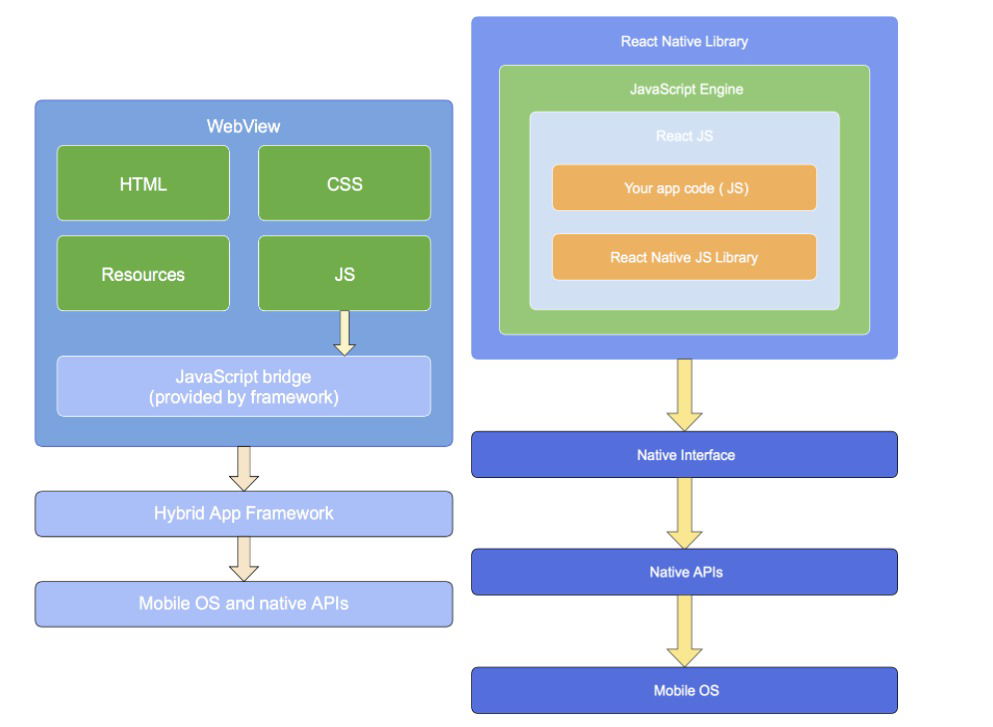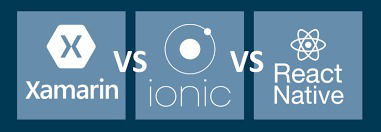Respond Native versus Xamarin versus Ionic versus Shudder: Which is best for Cross-Platform Mobile App Development?
While creating Native Mobile Apps, Android applications are written in Java, and iOS ones in Swift and Objective-C. Almost certainly, this methodology conveys applications that are immaculate and high performing. Yet, the improvement way this methodology pursues is very tedious and costly in light of the fact that a similar code must be composed twice. All in all, what is the answer for complete the things in a consistent manner without contributing a ton of assets? The appropriate response is: Cross-stage Android Application Development Company Boston .

The methodology empowers designers to compose the code once and apply a couple of areas of it over every one of the stages to spare the improvement time. In any case, the applications this methodology conveys need some place in execution when contrasted and completely local applications created utilizing local dialects.
Accordingly, to expel this line of contrast among local and cross-stage portable applications, the application advancement networks are endeavoring hard to grow new systems and devices that can contend with local applications as well as can possibly win. Xamarin, React Native, Ionic and Flutter are well known instances of such apparatuses.
In this blog, we will contrast these devices with discover their motivation, the characteristics that make them not the same as each other and the best one that you ought to pick. In this way, how about we make a plunge.
Top 8 Attributes to Consider While Selecting the Platforms for Cross-stage Mobile Application Development Company Boston
To choose which one is better for Cross-Platform Mobile App Development gives initial a chance to characterize the characteristics dependent on which we will look at all of the abovementioned. What's more, these are:
The Language Stack
Execution
UI
Market and Community
Upheld Platforms
Code Sharing
Well known Apps
Estimating
The Comparison: React Native versus Xamarin versus Ionic versus Shudder
1. The Language Stack
How about we see which structure uses which programming dialects and offer what benefits:
Respond Native: It uses JavaScript which is at present one of the most well known, dynamic and significant level programming language. It joins the upsides of JavaScript and React.JS, and is supported by Facebook.
The strong side of React Native that makes it best among the other three systems as far as PL is that it permits composing a couple of parts in Swift, Objective-C or Java when designers require them. Using local modules and libraries in React Native applications, you can oversee computationally overwhelming tasks like video taking care of or picture altering.
Xamarin: It uses C# with .net condition to create Android, iOS and Mac applications. Anything that can be cultivated with local dialects, an engineer can do in C# using Xamarin. Nonetheless, designers can't use local open-source libraries available for iOS and Android with Xamarin, there is an assortment of .net libraries open that fills the pined for need.
IONIC: It utilizes HTML5, CSS, and JS to create and run applications, and requires Cordova wrapper to get to local stage controllers. Using IONIC, you can likewise utilize TypeScript that improves the nature of the code.
Vacillate: It uses Dart to grow top notch applications for Android, iOS and the web. Dart is a stunning Programming language that offer a lot of advantages and depends on C/C++ and java. Notwithstanding being new, the language is before long expected to overwhelm the business.
Here is the means by which you can rank these systems dependent on the favorable circumstances offered by their programming dialects:
2. Execution
This property is simply the most significant one and justifies itself – how do the applications made in various structures perform from a run-time execution point of view?
Respond Native: The presentation it gives is fundamentally the same as local applications as it renders code components explicitly to the local APIs. Respond moreover enable engineers to utilize local modules written in local dialects to compose code for convoluted activities. In any case, they can't be reused crosswise over two stages; their fundamental reason for existing is to give better.
Xamarin: Xamarin execution is additionally considered as being shut to local. Xamarin has two different ways to manufacture versatile applications and that is Xamarin.Android/Xamarin.iOS and Xamarin.Forms.
Xamarin.Android/iOS applications perform like local in light of the fact that their cross-stage limits are centered basically around sharing business method of reasoning instead of codebase. It accomplishes the local execution that is unimaginable with arrangements that translate code at runtime.
Be that as it may, Xamarin.Forms approach is focused on wide code imparting to less stage explicit conduct. This out and out reductions code execution in various tasks contrasted with various stages.
Ionic: as far as execution, Ionic looses the game. Its presentation isn't as like local as Xamarin, React Native or shudder offers since it uses web advancements to render an application. This methodology essentially diminishes the speed. Additionally, it doesn't use local segments, and attempts to make local look and feel by utilizing web innovations.
The upside of Ionic is its speedy testing process that runs in a flash in a program that streamlines the advancement procedure.
Vacillate: When looked at based on application execution, the Flutter takes the crown over its rivals. Since it has favorable circumstances of Dart and there is no JavaScript connect for beginning cooperations with the gadget local parts, the speed it offers is astounding.

Here is the means by which you can rank these systems dependent on the presentation they offer:
3. Graphical User Interface
Clients judge applications inside the initial couple of moments of use and that is the reason GUI of an application must draw in while being simple – we should perceive what these structure offers:
Respond Native: React Native modules partner with local UI controllers, which gives astonishing client experience that is exceptionally near local applications. It moreover uses the ReactJS library with broad UI components and streamlines the UI improvement in Mobile Application Development Company in Boston .
Xamarin: It empowers you to make the UI in two unique manners: using Xamarin.Android/iOS or Xamarin.Forms. The primary takes a lot of time, yet ensures local look and feel as far as UX.
With Xamarin.Forms you can make the improvement procedure altogether snappier and save a ton of assets yet at the expense of nearby look and feel. It very well may be a decent answer for inward and corporate endeavors, where the UI part isn't as fundamental as in the open applications.
Ionic: Ionic UI doesn't use local components at all and renders everything in HTML and CSS. At that point it applies Cordova to give local versatile experience. Precise parts that go with the system likewise empower Ionic applications resemble the local ones.
Shudder: Flutter gives the best User Interfaces. Almost certainly Ionic and Xamarin give us cross stage applications yet their productivity and execution can't beat Flutter and React Native. They stuck and need responsiveness if application is overwhelming and progressively local UI parts are utilized.
Here is the way you can rank these systems dependent on the UI they offer:
4. Market and Community
Having a unique biological system is something worth being appreciative for – yet it is important how well known is an alternative? How about we see:
Respond Native: React Native is the lord with regards to market and network acknowledgment. The system of its designers is rapidly developing and starting at now has many experienced React Native Engineers. This makes it simple to kick start a React venture. It uses an incredibly mainstream library (React) and the most fundamental web improvement language (JavaScript) and gives genuine local applications. These characteristics make it a solid stage and are the purposes for its notoriety.
Ionic: It is the second most mainstream structure after React. It engages designers to fabricate local portable applications in the quickest conceivable manner.
Xamarin: Xamarin is additionally a calm prominent structure. What's more, still Microsoft is placing a ton of endeavors into becoming the Xamarin people group. Engineers who work inside the Microsoft biological system can without quite a bit of a stretch start working with the development as a result of its dynamic help.
Ripple: Flutter is another structure for network at the present time and not prevalent. However, it's strongly publicized by Google that shows they need to make it a significant thing in versatile world. While despite everything it has some shiver focuses, utilizing it is fun and you can go quickly from thought to model to application.
Here is the means by which you can rank these structures dependent on their industry acknowledgment and dependability:
5. Bolstered Platforms
Respond Native: Android 4.1+ , iOS 8+
Xamarin: Android 4.0.3+ , iOS 8+ , Window 10
Ionic: Android 4.4+ , iOS 8+ , Windows 10
6. Code Reusability
With this Attribute, you will get a thought of the amount of the code you compose can be re-utilized for the two stages which is the primary motivation behind these structures.
Respond Native: The system utilizes local parts written in Objective-C, Swift or Java to improve the application execution. However, these local parts can't be reused over different stages. Along these lines, designers need to do a little work for changing this specific codebase. Notwithstanding, acknowledge these local segments whatever is left of the codebase (around 90%) can be re-utilized.
Xamarin: It doesn't require exchanging between the advancements conditions: all Xamarin applications are created in Visual Studio. Normally, up to 96 percent of source code can be reused with Xamarin.Forms that rates up the advancement procedure.
Ionic: A fundamental piece of the applications created in Ionic is their comprehensiveness. Whatever the OS given, they will work likewise well on all of them. Be that as it may, some UI segments should be changed to the guidelines managed by a specific stage, which will require additional endeavors.
Vacillate: In respond Native, we have prepared to-utilize capacities, which quickens the speed of improvement. Notwithstanding, in Flutter, we have to include committed records for both Android and iOS stage contingent on their guidelines.
Here is the means by which you can rank these systems dependent on their code reusability:
Prevalent Apps
Respond Native: Facebook, Instagram, Airbnb, UberEats
Xamarin: Olo, the World Bank, Storyo.
Ionic: JustWatch, Pacifica, Nationwide and some more.
Vacillate: Hamilton
7. Evaluating
Respond Native and Flutter: Both are totally open source systems. Architects can use these framework and their libraries for nothing.
Xamarin: Xamarin expects designers to introduce IDE, which is given on a membership premise. Be that as it may, it likewise offers a free release for understudies and non-undertaking adventures with up to 5 clients.
Ionic: It is a free open source structure for creating cross stage versatile applications. Be that as it may, the association offers its Pro form which is paid. The organization ensures that Ionic Pro quickens improvement process.
Resource: https://ello.co/anvisingh/post/o7bv49jq-wn3izudmekk9g



